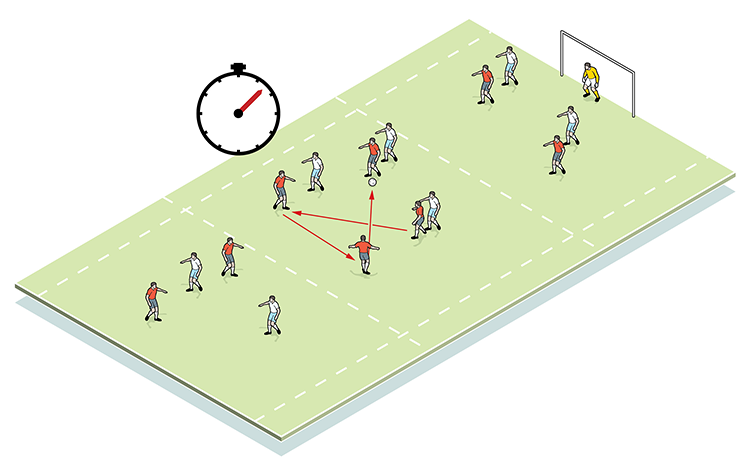Extra man and overload play
This progressive practice session trains players in the usefulness of forward passing and the benefits of overloading areas.

| Area | 80x18 yards, the length divided into the three areas (25, 30 and 25 yards) |
| Equipment | Cones, goals, balls |
| No. of Players | 10 |
This is a progressive practice session that trains players in the usefulness of forward passing and the benefits of overloading areas. The session embraces all key elements of the game, including freeing up space, keeping possession, making passing angles and, notably, finishing.
The practice starts with a basic set-up and designated players in each third of the pitch, but a coach can add difficulty by increasing playing numbers and adjusting the size of the zones, up to a point where the entire squad is involved.
What do I get the players to do?
The coach serves a ball into the defensive third where one of the two defenders receives possession. The lone opposition player works to delay play and, if possible, intercept and clear.
In this 2v1 situation a pass is played into the middle third where there is a 2v2 arrangement. Once the ball has been received, either of the defenders can move forward to make a 3v2 overload (1a).
1a

The three in the middle zone now work to keep the ball against the two defenders before the opportunity to pass forward to the final zone, where there is a 1v1 situation. Once the ball is moved forward, one of the middle three advances to make a 2v1 (1b), the two working for an early shot at goal (1c).
1b

1c

What are the key things to look out for tactically/technically?
An appreciation of when and where to pass is crucial, as is the use of soft, angled and shorter passes, plus positive and early shots at goal. Players need to work for space whilst retaining possession, so the timing and communication of forward runs is essential. Players should never get caught square of each other, and movement towards and away from the ball (‘going’ and ‘checking’) is important in creating space.
How do I progress the session?
There are several progressions including:
a. The playing area is enlarged and more players added (2a)
b. The player who played the ball into the next zone cannot be the player who advances - one of his team-mates must react instead.
c. Players must keep the ball for a specified time before being joined by a new player or progressing themselves (2b).
2a

2b

d. When the ball enters the attacking zone, a strike on goal must be achieved within a certain amount of time.
e. At the end of an attack, the move can be reversed so that the opposite end is attacked - another goal and keeper is required.
f. After an attack is completed, a server crosses the ball into the attacking zone for a goalkeeping practice (2c).
2c

The set-up for this practice is perfect for any imaginative coach because the variations and aims are endless.
Editor's Picks
Attacking transitions
Deep runs in the final third
Using the goalkeeper in build-up play
Intensive boxes drill with goals
Penetrating the final third
Creating and finishing
My philosophy
Pressing initiation
Compact team movement
Coaches' Testimonials

Alan Pardew

Arsène Wenger

Brendan Rodgers

Carlos Carvalhal

José Mourinho

Jürgen Klopp

Pep Guardiola

Roy Hodgson

Sir Alex Ferguson

Steven Gerrard
Coaches' Testimonials

Gerald Kearney, Downtown Las Vegas Soccer Club

Paul Butler, Florida, USA

Rick Shields, Springboro, USA

Tony Green, Pierrefonds Titans, Quebec, Canada
Join the world's leading coaches and managers and discover for yourself one of the best kept secrets in coaching. No other training tool on the planet is written or read by the calibre of names you’ll find in Elite Soccer.
In a recent survey 92% of subscribers said Elite Soccer makes them more confident, 89% said it makes them a more effective coach and 91% said it makes them more inspired.
Get Monthly Inspiration
All the latest techniques and approaches
Since 2010 Elite Soccer has given subscribers exclusive insight into the training ground practices of the world’s best coaches. Published in partnership with the League Managers Association we have unparalleled access to the leading lights in the English leagues, as well as a host of international managers.
Elite Soccer exclusively features sessions written by the coaches themselves. There are no observed sessions and no sessions “in the style of”, just first-hand advice delivered direct to you from the coach.









